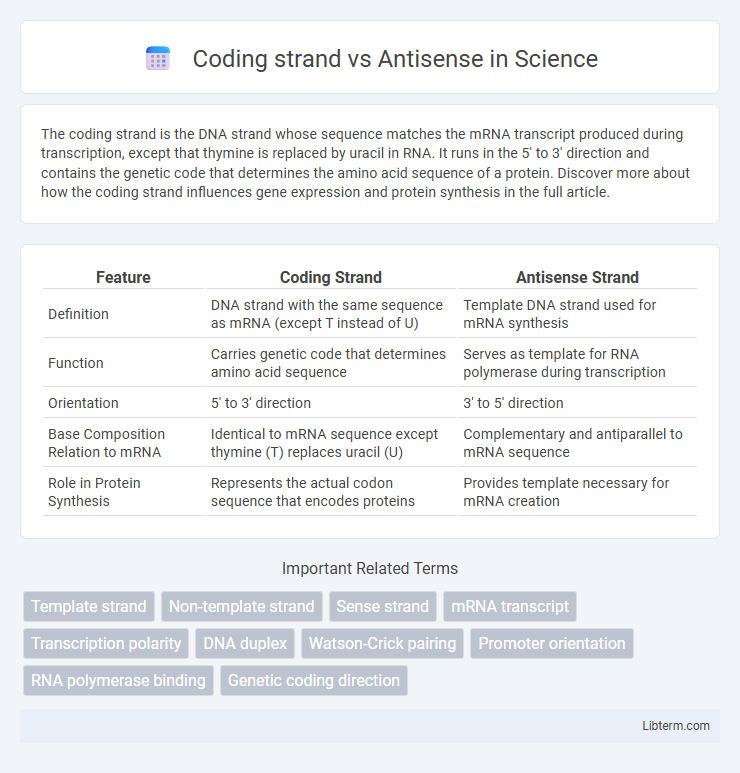The coding strand is the DNA strand whose sequence matches the mRNA transcript produced during transcription, except that thymine is replaced by uracil in RNA. It runs in the 5' to 3' direction and contains the genetic code that determines the amino acid sequence of a protein. Discover more about how the coding strand influences gene expression and protein synthesis in the full article.
Table of Comparison
| Feature | Coding Strand | Antisense Strand |
|---|---|---|
| Definition | DNA strand with the same sequence as mRNA (except T instead of U) | Template DNA strand used for mRNA synthesis |
| Function | Carries genetic code that determines amino acid sequence | Serves as template for RNA polymerase during transcription |
| Orientation | 5' to 3' direction | 3' to 5' direction |
| Base Composition Relation to mRNA | Identical to mRNA sequence except thymine (T) replaces uracil (U) | Complementary and antiparallel to mRNA sequence |
| Role in Protein Synthesis | Represents the actual codon sequence that encodes proteins | Provides template necessary for mRNA creation |
Overview of Coding and Antisense Strands
The coding strand of DNA carries the same sequence as the mRNA transcript, except thymine is replaced by uracil in RNA, and serves as the reference for protein synthesis. The antisense strand, also called the template strand, is complementary to the coding strand and directs RNA polymerase during transcription. Together, these strands ensure accurate gene expression by providing both the informational and template sequences required for producing functional proteins.
Definition of Coding Strand
The coding strand, also known as the sense strand, is the DNA strand whose sequence matches the mRNA transcript produced during transcription, except that thymine (T) is replaced by uracil (U) in RNA. It contains the genetic code that directly corresponds to the amino acid sequence of the encoded protein. In contrast, the antisense strand serves as the template for RNA synthesis, being complementary to both the coding strand and the RNA transcript.
Definition of Antisense Strand
The antisense strand, also known as the template strand, is the DNA strand used as a template for RNA synthesis during transcription. It runs in the 3' to 5' direction and is complementary to the coding strand, which matches the RNA sequence except for thymine being replaced by uracil. This strand plays a critical role in gene expression by guiding the production of messenger RNA (mRNA) that directs protein synthesis.
DNA Transcription Process
The coding strand of DNA contains the same sequence as the messenger RNA (mRNA) except it has thymine instead of uracil, while the antisense strand serves as the template for RNA polymerase during transcription. RNA polymerase binds to the antisense strand and synthesizes mRNA in the 5' to 3' direction, complementary to the antisense strand. This process ensures that the mRNA sequence corresponds to the coding strand, which determines the amino acid sequence during translation.
Differences Between Coding and Antisense Strands
The coding strand of DNA carries the same sequence as the mRNA transcript, except it contains thymine instead of uracil, while the antisense strand serves as the template for RNA polymerase during transcription. The antisense strand is complementary to both the coding strand and the resulting mRNA, ensuring accurate synthesis of the RNA message. Functionally, the coding strand defines the gene's nucleotide sequence, whereas the antisense strand directly guides the assembly of nucleotides into a complementary RNA molecule.
Role of Each Strand in mRNA Synthesis
The coding strand of DNA contains the same sequence as the mRNA transcript and serves as the reference for the genetic code, while the antisense strand acts as the template during transcription by RNA polymerase. RNA polymerase reads the antisense strand in the 3' to 5' direction, synthesizing a complementary mRNA strand in the 5' to 3' direction. The antisense strand's role is essential for accurate mRNA synthesis, ensuring the coding strand's sequence is correctly represented in the mRNA transcript.
Genetic Code Interpretation
The coding strand of DNA carries the same sequence as the mRNA transcript, using thymine (T) instead of uracil (U), making it crucial for interpreting the genetic code into proteins. The antisense strand serves as the template for RNA polymerase during transcription, ensuring accurate complementary base pairing with mRNA. Understanding the distinction between these strands is essential for decoding genetic information and synthesizing functional proteins.
Importance in Gene Expression
The coding strand, also known as the sense strand, carries the DNA sequence that directly corresponds to the mRNA codons encoding proteins. The antisense strand serves as the template for RNA polymerase during transcription, ensuring accurate synthesis of complementary mRNA. Proper interaction between coding and antisense strands is critical for precise gene expression, as it dictates the production of functional proteins essential for cellular processes.
Biological Implications of Strand Orientation
The coding strand carries the same sequence as the mRNA and dictates the amino acid sequence of proteins during translation, making strand orientation crucial for gene expression. The antisense strand serves as the template for mRNA synthesis, ensuring accurate transcription by complementary base pairing. Misinterpretation or mutation in either strand can lead to frameshifts or nonfunctional proteins, impacting cellular function and organismal development.
Applications in Molecular Biology and Research
The coding strand, also known as the sense strand, carries the same sequence as the mRNA and is essential for designing primers and probes in PCR and gene expression studies. The antisense strand serves as the template for RNA synthesis during transcription, making it crucial for creating antisense oligonucleotides to regulate gene expression and study gene function. Both strands are key targets in molecular cloning, RNA interference, and CRISPR-based genome editing techniques.
Coding strand Infographic

 libterm.com
libterm.com